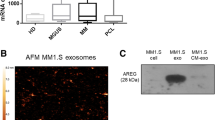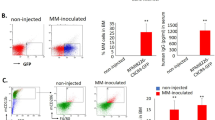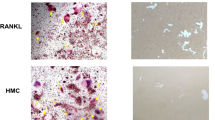Abstract
Multiple myeloma (MM) cell adhesion to stromal cells via very late antigen (VLA)-4 and vascular cell adhesion molecule (VCAM)-1 interaction causes enhanced secretion of osteoclastogenic activity by MM cells. We have reported that MM cell-derived macrophage inflammatory protein (MIP)-1α and MIP-1β are responsible for most of the osteoclastogenic activity in MM. Thus, adhesion-mediated osteoclastogenesis may be caused by enhanced production of MIP-1 via VLA-4–VCAM-1 interaction. The present study was undertaken to clarify whether MM cell-derived MIP-1 plays a role in VLA-4–VCAM-1 adhesion-mediated osteoclastogenesis. Adhesion of MM cells to VCAM-1 upregulated MIP-1α and MIP-1β production from MM cells and enhanced production of osteoclastogenic activity by MM cells. Blockade of MIP-1α and MIP-1β actions not only abrogated elaboration of osteoclastogenic activity, but also suppressed spontaneous MM cell adhesion to VCAM-1. These results demonstrate that MM cell adhesion to VCAM-1 upregulates MIP-1 production by MM cells to cause enhancement of osteoclastogenesis. In addition, the results suggest that the increased production of MIP-1 further enhances MM cell binding to stromal cells via stimulation of VLA-4–VCAM-1 adhesion, forming a “vicious cycle” between MM cell adhesion to stromal cells and MIP-1 production via VLA-4–VCAM-1 interaction.






Similar content being viewed by others
References
Choi SJ, Cruz JC, Craig F, Chung H, Devlin RD, Roodman GD, Alsina M (2000) Macrophage inflammatory protein 1-alpha is a potential osteoclast stimulatory factor in multiple myeloma. Blood 96:671–675
Abe M, Hiura K, Wilde J, Moriyama K, Hashimoto T, Ozaki S, Wakatsuki S, Kosaka M, Kido S, Inoue D, Matsumoto T (2002) Role for macrophage inflammatory protein (MIP)-1alpha and MIP-1beta in the development of osteolytic lesions in multiple myeloma. Blood 100:2195–2202
Hashimoto T, Abe M, Oshima T, Shibata H, Ozaki S, Inoue D, Matsumoto T (2004) Ability of myeloma cells to secrete macrophage inflammatory protein (MIP)-1alpha and MIP-1beta correlates with lytic bone lesions in patients with multiple myeloma. Br J Haematol 125:38–41
Caligaris-Cappio F, Bergui L, Gregoretti MG, Gaidano G, Gaboli M, Schena M, Zallone AZ, Marchisio PC (1991) Role of bone marrow stromal cells in the growth of human multiple myeloma. Blood 77:2688–2693
Roodman GD (2002) Role of the bone marrow microenvironment in multiple myeloma. J Bone Miner Res 17:1921–1925
Nefedova Y, Landowski TH, Dalton WS (2003) Bone marrow stromal-derived soluble factors and direct cell contact contribute to de novo drug resistance of myeloma cells by distinct mechanisms. Leukemia 17:1175–1182
De Raeve HR, Vanderkerken K (2005) The role of the bone marrow microenvironment in multiple myeloma. Histol Histopathol 20:1227–1250
Damiano JS, Cress AE, Hazlehurst LA, Shtil AA, Dalton WS (1999) Cell adhesion mediated drug resistance (CAM-DR): role of integrins and resistance to apoptosis in human myeloma cell lines. Blood 93:1658–1667
Dalton WS, Hazlehurst L, Shain K, Landowski T, Alsina M (2004) Targeting the bone marrow microenvironment in hematologic malignancies. Semin Hematol 41:1–5
Faid L, Van Riet I, De Waele M, Facon T, Schots R, Lacor P, Van Camp B (1996) Adhesive interactions between tumour cells and bone marrow stromal elements in human multiple myeloma. Eur J Haematol 57:349–358
Sanz-Rodriguez F, Ruiz-Velasco N, Pascual-Salcedo D, Teixido J (1999) Characterization of VLA-4-dependent myeloma cell adhesion to fibronectin and VCAM-1. Br J Haematol 107:825–834
Hideshima T, Chauhan D, Podar K, Schlossman RL, Richardson P, Anderson KC (2001) Novel therapies targeting the myeloma cell and its bone marrow microenvironment. Semin Oncol 28:607–612
Michigami T, Shimizu N, Williams PJ, Niewolna M, Dallas SL, Mundy GR, Yoneda T (2000) Cell-cell contact between marrow stromal cells and myeloma cells via VCAM-1 and alpha(4)beta(1)-integrin enhances production of osteoclast-stimulating activity. Blood 96:1953–1960
Mori Y, Shimizu N, Dallas M, Niewolna M, Story B, Williams PJ, Mundy GR, Yoneda T (2004) Anti-alpha4 integrin antibody suppresses the development of multiple myeloma and associated osteoclastic osteolysis. Blood 104:2149–2154
Rice GE, Munro JM, Bevilacqua MP (1990) Inducible cell adhesion molecule 110 (INCAM-110) is an endothelial receptor for lymphocytes. A CD11/CD18-independent adhesion mechanism. J Exp Med 171:1369–1374
Goto T, Kennel SJ, Abe M, Takishita M, Kosaka M, Solomon A, Saito S (1994) A novel membrane antigen selectively expressed on terminally differentiated human B cells. Blood 84:1922–1930
Takada Y, Kusuda M, Hiura K, Sato T, Mochizuki H, Nagao Y, Tomura M, Yahiro M, Hakeda Y, Kawashima H (1992) A simple method to assess osteoclast-mediated bone resorption using unfractionated bone cells. Bone Miner 17:347–359
Alsina M, Boyce B, Devlin RD, Anderson JL, Craig F, Mundy GR, Roodman GD (1996) Development of an in vivo model of human multiple myeloma bone disease. Blood 87:1495–1501
Choi SJ, Oba Y, Gazitt Y, Alsina M, Cruz J, Anderson J, Roodman GD (2001) Antisense inhibition of macrophage inflammatory protein 1-alpha blocks bone destruction in a model of myeloma bone disease. J Clin Invest 108:1833–1841
Tanaka Y, Adams DH, Hubscher S, Hirano H, Siebenlist U, Shaw S (1993) T-cell adhesion induced by proteoglycan-immobilized cytokine MIP-1 beta. Nature 361:79–82
Tanaka Y, Mine S, Figdor CG, Wake A, Hirano H, Tsukada J, Aso M, Fujii K, Saito K, van Kooyk Y, Eto S (1998) Constitutive chemokine production results in activation of leukocyte function-associated antigen-1 on adult T-cell leukemia cells. Blood 91:3909–3919
Tanaka Y, Mine S, Hanagiri T, Hiraga T, Morimoto I, Figdor CG, van Kooyk Y, Ozawa H, Nakamura T, Yasumoto K, Eto S (1998) Constitutive up-regulation of integrin-mediated adhesion of tumor-infiltrating lymphocytes to osteoblasts and bone marrow-derived stromal cells. Cancer Res 58:4138–4145
Kinashi T (2005) Intracellular signalling controlling integrin activation in lymphocytes. Nat Rev Immunol 5:546–559
Miyamoto A, Kunisada T, Hemmi H, Yamane T, Yasuda H, Miyake K, Yamazaki H, Hayashi SI (1998) Establishment and characterization of an immortal macrophage-like cell line inducible to differentiate to osteoclasts. Biochem Biophys Res Commun 242:703–709
Nakagawa N, Kinosaki M, Yamaguchi K, Shima N, Yasuda H, Yano K, Morinaga T, Higashio K (1998) RANK is the essential signaling receptor for osteoclast differentiation factor in osteoclastogenesis. Biochem Biophys Res Commun 253:395–400
Simonet WS, Lacey DL, Dunstan CR, Kelley M, Chang MS et al (1997) Osteoprotegerin: a novel secreted protein involved in the regulation of bone density. Cell 89:309–319
Kong YY, Yoshida H, Sarosi I, Tan HL, Timms E, Capparelli C, Morony S, Oliveira-dos-Santos AJ, Van G, Itie A, Khoo W, Wakeham A, Dunstan CR, Lacey DL, Mak TW, Boyle WJ, Penninger JM (1999) OPGL is a key regulator of osteoclastogenesis, lymphocyte development and lymph-node organogenesis. Nature 397:315–323
Dougall WC, Glaccum M, Charrier K, Rohrbach K, Brasel K, De Smedt T, Daro E, Smith J, Tometsko ME, Maliszewski CR, Armstrong A, Shen V, Bain S, Cosman D, Anderson D, Morrissey PJ, Peschon JJ, Schuh J (1999) RANK is essential for osteoclast and lymph node development. Genes Dev 13:2412–2424
Pearse RN, Sordillo EM, Yaccoby S, Wong BR, Liau DF, Colman N, Michaeli J, Epstein J, Choi Y (2001) Multiple myeloma disrupts the TRANCE/osteoprotegerin cytokine axis to trigger bone destruction and promote tumor progression. Proc Natl Acad Sci USA 98:11581–11586
Giuliani N, Bataille R, Mancini C, Lazzaretti M, Barille S (2001) Myeloma cells induce imbalance in the osteoprotegerin/osteoprotegerin ligand system in the human bone marrow environment. Blood 98:3527–3533
Sezer O, Heider U, Zavrski I, Kuhne CA, Hofbauer LC (2003) RANK ligand and osteoprotegerin in myeloma bone disease. Blood 101:2094–2098
Van de Broek I, Leleu X, Schots R, Facon T, Vanderkerken K, Van Camp B, Van Riet I (2006) Clinical significance of chemokine receptor (CCR1, CCR2 and CXCR4) expression in human myeloma cells: the association with disease activity and survival. Haematologica 91:200–206
Yaccoby S, Wezeman MJ, Henderson A, Cottler-Fox M, Yi Q, Barlogie B, Epstein J (2004) Cancer and the microenvironment: myeloma-osteoclast interactions as a model. Cancer Res 64:2016–2023
Abe M, Hiura K, Wilde J, Shioyasono A, Moriyama K, Hashimoto T, Kido S, Oshima T, Shibata H, Ozaki S, Inoue D, Matsumoto T (2004) Osteoclasts enhance myeloma cell growth and survival via cell-cell contact: a vicious cycle between bone destruction and myeloma expansion. Blood 104:2484–2491
Abe M, Kido S, Hiasa M, Nakano A, Oda A, Amou H, Matsumoto T (2006) BAFF and APRIL as osteoclast-derived survival factors for myeloma cells: a rationale for TACI-Fc treatment in patients with multiple myeloma. Leukemia 20:1313–1315
Acknowledgments
We thank Ms. Hiroe Amou, Ms. Asuka Oda, and Dr. Masahiro Hiasa for their expert technical assistance. This work was supported in part by Grants-in-Aid for Scientific Research (A) to T. M. and (C) to M. A., and for the 21st Century Center of Excellence Program from the Ministry of Education, Culture, Science, and Sports of Japan, and a Grant-in-Aid for Cancer Research (17-16) from the Ministry of Health, Labor, and Welfare of Japan.
Author information
Authors and Affiliations
Corresponding author
About this article
Cite this article
Abe, M., Hiura, K., Ozaki, S. et al. Vicious cycle between myeloma cell binding to bone marrow stromal cells via VLA-4–VCAM-1 adhesion and macrophage inflammatory protein-1α and MIP-1β production. J Bone Miner Metab 27, 16–23 (2009). https://doi.org/10.1007/s00774-008-0012-z
Received:
Accepted:
Published:
Issue Date:
DOI: https://doi.org/10.1007/s00774-008-0012-z




